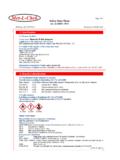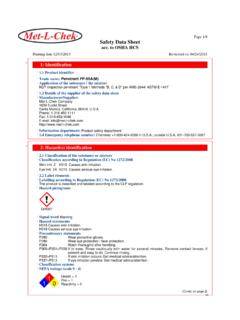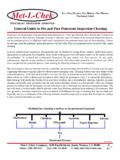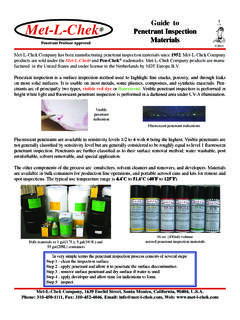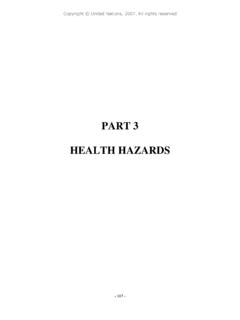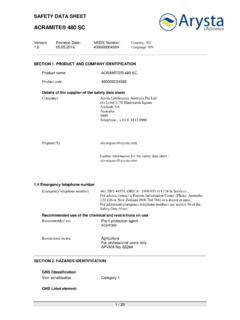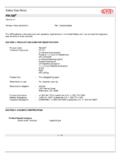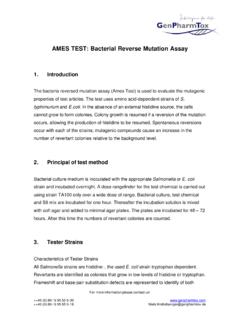Transcription of Met-L-Chek Safety Data Sheet E-59A(aerosol)
1 Safety data SheetE-59A( aerosol )Page 1 of 5 Date Revised 6/12/2015 Supersedes 12/2014 Met-L-Chek 1 Product and Company identification: Product Name: E-59A Cleaner/Remover ( aerosol )Manufacturer: Met-L-Chek Company 1639 Euclid Street Santa Monica, California, 90404, Phone: +1-310-450-1111 Fax: +1-310-452-4046E-mail: Phone #: Chemtrec +1-800-424-9300 in ; outside 001-703-527-3887 Recommended Use: NDT Inspection cleaner/remover per ASTM E-165 & ASTM E-1417, class on Use: Flammable, avoid use near open flames or ignition source, avoid concentrated vapors, aspiration by: Met-L-Chek Company 6/12/20152 Hazards identification:GHS: Classification: Extremely flammable aerosol (category 1) Aspiration hazard (category 1) Skin irritation (category 2) Eye irritation (category 2A) Germ cell mutagenicity (category 1B) Carcinogenicity (category 1B) Specific target organ toxicity - single exposure (category 3), Central nervous system.
2 Pictogram:Signal Word: DangerHazard Statements: H222: Extremely flammable aerosol H229: Pressurized container, may burst if heated. H304: May be fatal if swallowed and enters airways. H315: Causes skin irritation. H319: Causes serious eye irritation. H336: May cause drowsiness or dizziness. H340: May cause genetic defects. H350: May cause cancer. Precautionary statements: P102: Keep out of reach of children. P202: Do not handle until all Safety precautions have been read and understood. P210: Keep away from heat, hot surfaces, sparks, open flames and other ignition sources. No smoking.
3 P241: Use explosion-proof electrical/ventilating/lighting/equipmen t. P251: Do not pierce or burn, even after use. P261: Avoid breathing dust/fumes/gas/mist/vapors/spray. P264: Wash skin thoroughly after handling. P-271: Use only outdoors or in well-ventilated area. P-273: Avoid release to the environment. P-280: Wear protective glove/clothing/eye protection/face protection. P-284: In case of inadequate ventilation wear respiratory protection. HMIS Classification: Health hazard-2, Flammability-4, Reactivity-0. WHMIS (Canada): A, B5, Company, 1639 Euclid Street, Santa Monica, California, 90404, : 310-450-1111 Fax: 310-452-4046 E-mail: Web: 2 of 5 Date Revised 6/12/2015 Supersedes 12/2014 Safety data SheetE-59A( aerosol )5 Fire-fighting Measures:Suitable extinguishing agents: Alcohol resistant foam, dry powder, carbon dioxide (CO2), water haze.
4 For Safety reasons water spray is an unsuitable extinguishing agent, but may be used to cool unopened combustion products: Carbon monoxide and carbon protective equipment for fire-fighters: Wear self-contained respiratory protective device. Wear fully protective hazards during firefighting: Do not allow run-off from fire fighting to enter drains or water courses. Collect contaminated fire extinguishing water separately and disposed of in accordance with local Point: 14-20 C(57- 68 F)TCC (bulk material) Explosive Limit: %(V)lower, %(V)upper (bulk material) Autoignition Temperature: 246-470 C (474-878 F) (bulk material) 6 Accidental Release Measures:Spill: Evacuate area. Ventilate area. Remove all sources of ignition. Wear protective gear. Vapors can accumulate in low areas to form explosive concentrations. Collect liquid in an appropriate container or absorb with an inert material such as vermiculite, dry sand, or earth; DO NOT use combustible materials.
5 Place in a chemical waste container. DO NOT flush to sewer. If the product contaminates rivers and lakes or drains inform respective First Aid Measures:GHS response statements:IF SWALLOWED: Immediately call a poison center/doctor/physician. Do Not induce ON SKIN: Wash with plenty of water. If skin irritation occurs, get medical INHALED: Remove person to fresh air and keep comfortable for breathing, get medical advice/attention if you feel IN EYES: Rinse cautiously with water for several minutes. Remove contact lenses, if present and easily to do. Continue rinsing, get medical ON CLOTHING: Take off contaminated clothing and wash it before Composition/information on ingrediants:Ingredient(s): CAS # % by Weight naphtha(petroleum) hydrotreated light 64742-49-0 50-100 solvent naphtha (petroleum) light aliphatic 64742-89-8 50-100distillates (petroleum) hydrotreated, low boiling 68410-97-9 50-100 Propellant (petroleum gas liquified) 68476-85-7 50-100 Met-L-Chek Potential Health Effects:Carcinogenicity: IARC:No component of this product present at levels greater than or equal to is identified as probable, possible or confirmed human carcinogen by IARC.
6 ACGIH: No component of this product present at levels greater than or equal to is identified as a carcinogen or potential carcinogen by ACGIH. OSHA: No component of this product present at levels greater than or equal to is identified as a carcinogen or potential carcinogen by OSHA. NTP: No component of this product present at levels greater than or equal to is identified as a known or anticipated carcinogen by Handling and Storage:Handling: Avoid contact with skin and eyes. Avoid inhalation of vapors or mist. Use explosion-proof equipment. Keep away from sources of ignition. Protect from build up of static charge, ground containers when transferring product. Containers may be hazardous when empty since residue liquid and vapors may be Company, 1639 Euclid Street, Santa Monica, California, 90404, : 310-450-1111 Fax: 310-452-4046 E-mail: Web: data SheetE-59A( aerosol )Page 3 of 5 Date Revised 6/12/2015 Supersedes 12/201411 Toxicological Information:Components CAS 68410-97-9/64742-49-0/64742-89-8 Acute toxicity oral: LD50 (rat, male and female): > 5,000 mg/kg, Method: OECD Test Guideline 401.
7 GLP: yes Assessment: The substance or mixture has no acute oral toxicity inhalation: Assessment: The substance or mixture has no acute inhalation toxicity dermal: LD50 (rabbit, male and female): > 2,000 mg/kg,Method: OECD Test Guideline 402. GLP: yes. Assessment: The substance or mixture has no acute dermal corrosion/irritation: Irritating to skin. Species: rabbit, Exposure time: 4 eye damage/irritation: Irritating to eyes. Species: or skin sensitisation: Test Type: Buehler Test Species: guinea pig. Did not cause sensitisation on laboratory cell mutagenicity: Positive result(s) from mutagenicity tests in mam-mals. Evidence that the substance has potential to cause mutations to germ : Possible human 9. Physical Properties: (bulk material)Form: clear colorless liquid. Density: g/cm3 at C(60 F)Boiling Point/Range: 118 -150 C (244 302 F) Flash Point:14 - 20 C(57 68 F)TCC Vapor Pressure: 11-16 mmHg @ 20 -25 C(68 -77 F) Specific Vapor Density Air=1: 4 Solubility in water: g/L Percent Volatile: 100 %, VOC s-750 g/L Autoignition Temperature: 246-470 C (474-878 F) Viscosity,kinematic: < 10 mm2/s @ 40 C(104 F Explosive Limit: %(V)lower, %(V)upper10.)
8 Stability and Reactivity:Reactivity: Stable under ordinary conditions of use and storage, under fire conditions will form carbon dioxide and other combustion by : Vapours may form explosive mixture with : Strong acids and oxidizing Exposure Controls/Personal Protection:Eye Protection: Chemical splash goggles, face Protection: Wear resistant gloves such as Nitrile Rubber, impervious clothing, apron and boots are suggested as System: A system of local or general exhaust is recommended to keep employee exposure below the airborne exposure limits. If exposure limit is exceeded use organic vapor respirator (type AXBEK or EN 14387) or self contained breathing Limits: Naphtha (petroleum) hydrotreated light ; CAS 64742-49-0 TWA 500 ppm/2000 mg/m3 (OSHA Table Z-1) TWA: 400 ppm/1600 mg/m3 (OSHA PO) Solvent Naphtha (petroleum) light aliphatic ; CAS 64742-89-8 TWA 500 ppm/2000 mg/m3 (OSHA Table Z-1) TWA: 400 ppm/1600 mg/m3 (OSHA PO) **Octane; CAS 111-65-9 TWA 300 ppm (ACGIH) TWA:75 ppm/350 mg/m3 (NIOSH REL) C: 385 ppm/1800 mg/m3 (NIOSH REL) TWA: 500 ppm/2350 mg/m3 (OSHA table Z-1) TWA: 300 ppm/1450 mg/m3 (OSHA PO) STEL: 375 ppm/1800 mg/m3 (OSHA PO)7 Handling and Storage: continuedStorage: Store in a cool, dry well-ventilated location, away from areas where fire hazard or ignition sources may exist.
9 Store and use in NO SMOKING area. Do not expose to temperatures over 50 C/122 F. Keep out of direct Company, 1639 Euclid Street, Santa Monica, California, 90404, : 310-450-1111 Fax: 310-452-4046 E-mail: Web: data SheetE-59A( aerosol )Page 4 of 5 Date Revised 6/12/2015 Supersedes 12/2014 Met-L-Chek 12 Ecological Information:Components CAS 68410-97-9/64742-49-0/64742-89-8 Ecotoxicity: Toxicity to fish: LC50 (Oncorhynchus mykiss (rainbow trout)): mg/l, Exposure time: 96 h, Test Type: semi-static test. Toxicity to daphnia and other aquatic invertebrates: EC50 (Daphnia magna (Water flea)): mg/l Exposure time: 48 h, Test Type: Immobilization, Analytical monitoring: yes Toxicity to algae: EC50 (Pseudokirchneriella subcapitata (green algae)): , Exposure time: 96 h Test Type: static test Ecotoxicology Assessment/Acute aquatic toxicity: Toxic to aquatic life. Chronic aquatic toxicity: Toxic to aquatic life with long lasting and degradability: Biodegradability: Concentration: mg/l, Result: Readily biodegradable.
10 Biodegradation: 77 % Testing period: 2 d, Exposure time: 28 d Mobility in soil: no data on notes: Regulation: 40 CFR Protection of Environment; Part 82 Protection of Stratospheric Ozone - CAA Section 602 Class I Substances. This product neither contains, nor was manufactured with a Class I or Class II ODS as defined by the Clean Air Act Section 602 (40 CFR 82, Subpt. A, An environmental hazard cannot be excluded in the event of unprofessional handling or disposal., Toxic to aquatic life with long lasting Disposal Considerations:Recommendation: Dispose of container and unused contents with a licensed waste facility. Empty containers may contain flammable residue and vapors. Must not be disposed together with household garbage. Do not allow product to reach ponds, water ways, sewage system, or soil. Collect all waste in suitable and labelled containers and dispose according to local Toxicological Information: continuedComponents CAS 68410-97-9/64742-49-0/64742-89-8 Reproductive toxicity: No toxicity to reproduction.)
